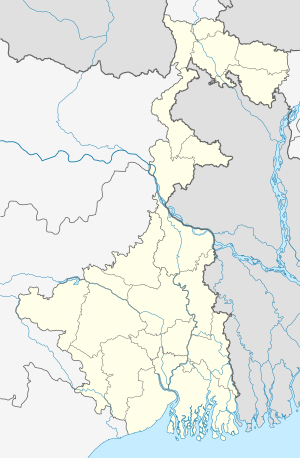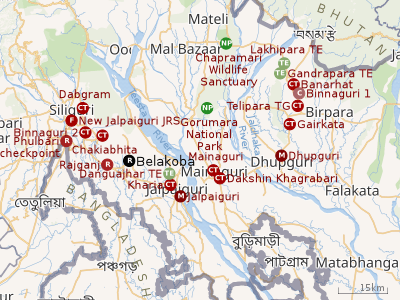Belakoba
Belakoba is a small town in Jalpaiguri Sadar subdivision of Jalpaiguri district in the Indian state of West Bengal, known for its Chamcham, a type of sweet originating in the Pora Bari locale of Bangladesh. Belakoba is not only a cradle to Chamcham, but also cradle to art and music. [1][2]
Belakoba | |
|---|---|
Town | |
Nameplate of Belakoba Rail Station | |
 Belakoba Location in West Bengal, India  Belakoba Belakoba (India) | |
| Coordinates: 26.590°N 88.589°E | |
| Country | |
| State | West Bengal |
| District | Jalpaiguri |
| Area | |
| • Total | 33.96 km2 (13.11 sq mi) |
| Population (2001) | |
| • Total | 17,615 |
| • Density | 520/km2 (1,300/sq mi) |
| Languages | |
| • Official | Bengali, English |
| Time zone | UTC+5:30 (IST) |
| Vehicle registration | WB |
| Lok Sabha constituency | Jalpaiguri |
| Vidhan Sabha constituency | Rajganj |
Geography
 |
| Places and tea estates in Jalpaiguri Sadar subdivision (including Rajganj, Jalpaiguri, Maynaguri and Dhupguri CD blocks) in Jalpaiguri district CT: census town, R: rural/ urban centre, N: neighbourhood, C: cantonment, NP: national park/ wildlife sanctuary, TE: tea estate Abbreviations used in names – TG for Tea Garden (town/village), TE for Tea Estate, JRS: junction railway station Owing to space constraints in the small map, the actual locations in a larger map may vary slightly |
Area overview
The map alongside shows the alluvial floodplains south of the outer foothills of the Himalayas. The area is mostly flat, except for low hills in the northern portions.[3][4]It is a primarily rural area with 62.01% of the population living in rural areas and a moderate 37.99% living in the urban areas.[5][6]Tea gardens in the Dooars and Terai regions produce 226 million kg or over a quarter of India's total tea crop. [7][8] Some tea gardens were identified in the 2011 census as census towns or villages. [9]Such places are marked in the map as CT (census town) or R (rural/ urban centre). Specific tea estate pages are marked TE.
Note: The map alongside presents some of the notable locations in the subdivision. All places marked in the map are linked in the larger full screen map.
Demographics
As per 2001 census, Belakoba had a total population of 21,615. Decadal growth for the district was 21.52 per cent.[2] Decadal growth in West Bengal was 17.84 per cent.[10]
Transportation
Belakoba is located 17 km distance from the city of Jalpaiguri, which is the district as well as the subdivisional headquarters & 28 km from the City of Siliguri, which is the largest city in the region. The town is 446 km far from its state capital city of Kolkata. Other nearest towns are Rajganj (9.2 km), Maynaguri (24.4 km), Mal (32.9 km). Belakoba has a well-developed transportation network. The town can be accessed by rail or roads. The Belakoba railway station serves the place directly.
Healthcare
Belacoba Rural Hospital, with 30 beds at Prasannanagar, is the major government medical facility in the Jalpaiguri CD block.[11]
References
- "Contact details of Town Development Officers". Jalpaiguri district. West Bengal Government. Archived from the original on 2 September 2011. Retrieved 20 March 2011.
- "Provisional Population Totals, West Bengal , Table 4". Census of India 2001, Jalpaiguri district (02). Census Commissioner of India. Archived from the original on 19 July 2011. Retrieved 20 March 2011.
- Debnath, S. (2010). The Dooars in Historical Transition (PDF). Shiv Mandir: N. L. Publishers.
- Dinerstein, E., Loucks, C. (2001). "Terai-Duar savanna and grasslands". Terrestrial Ecoregions. World Wildlife Fund.
- "Jalpaiguri". District Profile. District administration. Retrieved 13 July 2020.
- "District Statistical Handbook 2014 Jalpaiguri". Tables 2.2, 2.4b,. Department of Planning and Statistics, Government of West Bengal. Retrieved 13 July 2020.CS1 maint: extra punctuation (link)
- "Tea Growing Regions". Dooars and Terai. Indian Tea Association. Retrieved 13 July 2020.
- "Dooars-Terai". Tea Board India. Retrieved 13 July 2020.
- "2011 Census – Primary Census Abstract Data Tables". West Bengal – District-wise. Registrar General and Census Commissioner, India. Retrieved 13 July 2020.
- "Provisional Population Totals, West Bengal. Table 4". Census of India 2001. Census Commission of India. Archived from the original on 21 July 2011. Retrieved 11 March 2011.
- "Health & Family Welfare Department" (PDF). Health Statistics – Rural Hospitals. Government of West Bengal. Retrieved 1 July 2020.